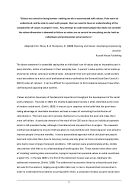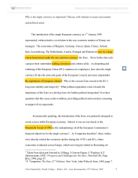Has Neofunctionalism Been Superseded By A New 'Liberal Intergovernmentalism" As Currently The Most Convincing Theoretical Explanation of European Political Integration?
Has Neofunctionalism Been Superseded By A New 'Liberal Intergovernmentalism" As Currently The Most Convincing Theoretical Explanation of European Political Integration? From an ambitious project originally envisaged to remove the catastrophe of war from such a war-torn continent, the European project has proceeded in 'fits and starts'. Since its inception, there has been much debate regarding what forces drive the integration process forward. Why now, when interstate war in Europe seems impossible, do member states continue to 'pool' their sovereignty in so many areas? Two theories have dominated previous attempts to answer the question of "how and why states cease to be wholly sovereign, how and why they voluntarily mingle, merge and mix with their neighbours, so as to lose the factual attributes of sovereignty."1 Neofunctionalism, the idea that the integration process, once started, develops its own momentum for further integration, saw the height of popularity in the 1960s, following the initial success of the ECSC/EEC and the hugely influential theoretical explanation by Ernst Haas. The second theory, Liberal Intergovernmentalism, surfaced in the 1990s and was championed by Andrew Moravcsik. It saw flaws in neofunctionalist thinking and instead offered an alternative account in which the integrative process was always, and remains, in the hands of national governments;
'All political parties are prey to the iron law of oligarchy.' Discuss
'All political parties are prey to the iron law of oligarchy.' Discuss The 'iron law of oligarchy' was a phrase first used by the German sociologist Roberto Michels in his book Political Parties, published in 1916. From historic insight and studies of both the German SPD and the Italian Socialist parties, Michels concluded that all parties, whatever their initial intensions, would be controlled by a political elite or oligarchy, who separated themselves, by the control of the bureaucracy, from the masses of their own party ranks. The reasons for this tendency towards oligarchy were the natural necessity for society to have a ruling class, the self fuelling desire for party officials to gain and retain power, and the effectiveness that centralised parties had in a political environment. Since 1916 Michels' work has gained a huge amount of support, particularly as the pressures of parties to centralise power is becoming more important in an increasingly competitive political world, but it is not without its critics. Opponents claim that Michels and his followers paint too black and white a picture and while there does seem to be a strong tendency for oligarchy to form, it can not be said to be an 'iron rule', as there are a number of examples where political parties have not taken on such a form. Much of Michels 'iron rule' theory was influenced heavily by Karl Marx'
Discuss Kohlberg's theory of Moral Development, use psychological evidence and refer to at least one other theory in your answer.
Discuss Kohlberg's theory of Moral Development, use psychological evidence and refer to at least one other theory in your answer Moral development in psychology is the study of how we form beliefs and acquire knowledge to determine what is wrong or right. It is also a study of how we apply these beliefs to our actions. Kohlberg is a prominent figure in moral development, his main focus in his investigation in to moral development was on our reasoning behind moral judgement rather than the judgments made. He believed that we develop moral reasoning during childhood and adolescence; it is not something we acquire in one big step. Like Piaget, Kohlberg chose to investigate the reasoning behind moral development, by using moral dilemmas. Kohlberg carried out a study with group of males, some of which he followed up 3 times over 20 years. He gave them a moral dilemma and questions designed by Heinz. Heinz's story stated that a man's wife was suffering from a rare illness, her only chance of survival was this one particular type of drug that the man could not afford and the chemist would not let him have it cheaper or let him pay for it in instalments. The questions were on whether the man should steal the drug for his wife, whether the man should steal it if it was for a stranger, is it against the law to steal it and does that make it morally wrong. From analysing the



















